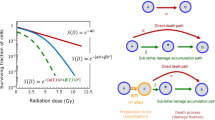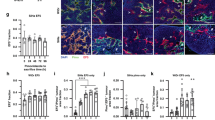Abstract
The cytotoxicity of 3 electron-affinic radiosensitizers has been studied in Chinese hamster V-79 cells as a function of pH and modest hyperthermia. When equitoxic concentrations were used and temperature was increased from 34 to 41 degrees C metronidazole, the compound with the lowest electron affinity showed the greatest enhancement of hypoxic-cell toxicity, and nitrofurantoin, the compound with the highest electron affinity, the least. The results can be explained if the mechanisms of toxicity involves a redox reaction, since it would be expected that the least toxic compound (lowest electron affinity) would have the largest activation energy and hence the greatest temperature effect. This appears to hold for these 3 compounds. Experiments also showed that nitrofurantoin which exhibits no increase in toxicity when the temperature was increased from 37 to 41 degrees C at pH 7.4, showed an increase in toxicity for the same temperature change at the pH of 7.0 and 6.6. Under aerobic conditions only metronidazole showed significant toxicity at 41 degrees C, where the differential between aerobic and hypoxic cell toxicity was minimal, both at pH 7.4, and at the low pH values of 7.0 and 6.6. In the clinical setting there is evidence that tumour cells are at a lower pH than their surrounding normal tissues. Hypoxic-cell cytotoxicity is enhanced at low pH, and even further enhanced at low pH in combination with a temperature of 41 degrees C. However, this finding correlates conversely with electron affinity. Thus, the radiosensitizer (and trichomonicide) metronidazole is most influenced by low pH and high temperature with the nitroimidazole, misonidazole, demonstrating a smaller enhancement due to higher temperatures.
This is a preview of subscription content, access via your institution
Access options
Subscribe to this journal
Receive 24 print issues and online access
$259.00 per year
only $10.79 per issue
Buy this article
- Purchase on Springer Link
- Instant access to full article PDF
Prices may be subject to local taxes which are calculated during checkout
Similar content being viewed by others
Rights and permissions
About this article
Cite this article
Rajaratnam, S., Adams, G., Stratford, I. et al. Enhancement of the cytotoxicity of radiosensitizers by modest hyperthermia: the electron-affinity relationship. Br J Cancer 46, 912–917 (1982). https://doi.org/10.1038/bjc.1982.301
Issue Date:
DOI: https://doi.org/10.1038/bjc.1982.301
This article is cited by
-
Effect of hyperthermia on the activity of 1-[(4?-hydroxy-2?-butenoxy)methyl]-2-nitroimidazole, which is cytotoxic to hypoxic cells
Cancer Chemotherapy and Pharmacology (1993)



